Solomon? – The Emperor With No Clothes
Supposedly, an Israelite empire flourished in the 10th century BC, during a time of temporary weakness of both Assyria and Egypt. Yet the fabled empire of David and Solomon remains just that: a fable, unsupported by any evidence – and empires normally leave a great deal of evidence. Archaeology is unequivocal: there was never the wealth, population, political cohesiveness, or literacy in the tiny settlement around Jerusalem to have ever dominated its more developed northern neighbours.
Imperial Israel?
The so-called ‘United Monarchy’ is found only in the Bible. The ’empire’ has no monuments, no inscriptions and no artifacts. Neither David nor Solomon is as much as mentioned in the huge corpus of state records of either Egypt or Assyria. Concedes a ‘pro-imperial Israel’ historian:
“Solomon … in the eyes of Israelite historians, marked the apex of Israelite achievement. Curiously, no reference to him or his father David, or their empire in a non-Israelite source is known … “
– Isserlin, The Israelites, p72.
But of course there is nothing ‘curious’ about a non-existent ’empire’ (stretching ‘from the Euphrates to Egypt’) leaving no evidence of its non-existence. Modern Israel is peppered with ‘Solomon’s monuments’ – but not one of them has any genuine claim to the appellation.
Solomon’s Empire?
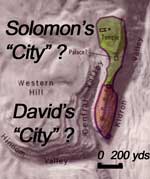
Hebrew hilltop settlements in the 10th century BC would not have been much larger than a soccer field, and archaeology has found not a brick of imperial grandeur.
‘Imperial’ Jerusalem?
Legendary kings David and Solomon supposedly had an imperial capital in Jerusalem. Yet extensive archaeology in the city reveals Jerusalem was a village in the 10th century BC. In contrast, Megiddo, ‘part of the empire.’ far to the north, had a palace!
In reality, separate and distinctive chiefdoms developed in Samaria and Judah in the 9th century. They were never a ‘united monarchy.’ The north was larger, richer and more developed – and soon succumbed to the Assyrians.
Judah, in reaction, produced its pious, biblical fraud, castigating the apostate kings of the 8th – 9th century northern kingdom of ‘Israel’ and elevated its own importance in an earlier, fantasised empire – ruled from an imperial capital of Jerusalem.
“… in Jerusalem nothing has as yet been brought to light which can be ascribed to Solomon with certainty.”
– Isserlin, p81.
Where did they get their ideas from? The Bible actually admits to borrowing from Assyria in 2 Kings 16:
| |||
| |||
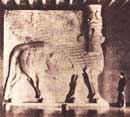
’10 cubit winged cherub’ – from Assyria!
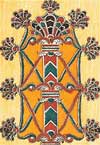
Palm & floral motif– from Assyrian temple!
Was it this … or this … or this?

7 years of slave labour?
Lavish Temple?
“Artist’s impressions” of that fabulous Temple are commonplace, all based upon the biblical fantasy.
Biblical descriptions of the building and its furniture are precise and vivid (1 Kings 6).
But then they would be – they were a ‘wish-list’ of 7th/6th century priests. Believe it or not, the 2 pillars had names – Jachin and Boaz.
“The archaeological evidence in Jerusalem for the famous building projects of Solomon is nonexistent.
19th and early 20th century excavations around the Temple Mount in Jerusalem failed to identify even a trace of Solomon’s fabled Temple or palace complex.”
– Finkelstein, Silberman, p128.
“Jehoash Tablet”

“First confirmation” of Solomon’s Jerusalem Temple?
Only one problem – manufactured in Jerusalem in 2003!
Solomon: Emperor with No Clothes
“But he has nothing on!” a little child cried out at last.”
– Hans Christian Andersen, The Emperor’s New Clothes
Solomon didn’t need to conquer anything – the Empire was his inheritance from his father David. Solomon merely ruled in magnificence, effortlessly receiving and spending an imperial fortune, collecting girlfriends and dispensing wisdom.
Really odd that no one seemed to have noticed. Could it all be a pious fraud, perhaps?
Royal “Chariot city” of Megiddo? | ||||||||||
| ||||||||||
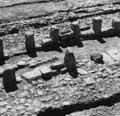
‘Solomon’s Stables’ – actually 8th century storehouses of Assyrian vassal Jeroboam II.
“Solomon’s Gates“? Wishful thinking – 9th century BC, not 10th.
Omri’s 9th century BC Megiddo
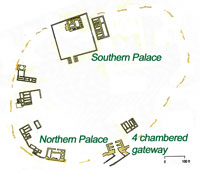
“Solomon’s 10th century BC Megiddo”?? No kidding
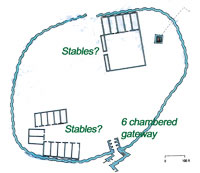
Reality:
“Solomon’s” Megiddo built on top of Omri’s!
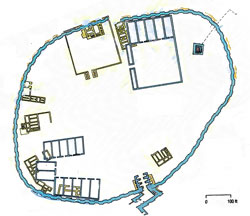
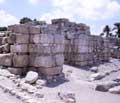
Megiddo
– Devastated by King Hazael of Aram-Damascus the city was “deserted for almost half a century”.
– Finkelstein, 204.
In the 1950s, Yigael Yadin – Israeli Defence Chief of Staff turned archaeologist – decided that the ruins of Megiddo, Hazor and Gezer were the legendary ‘Fortress Cities’ of Solomon.
“Our great guide was the Bible” he said. Thus he confirmed the Bible with the Bible.
This was despite an absence of any find at the sites naming Solomon – but a cartouche naming Pharaoh Amenhotep III instead!
Destruction of the sites was attributed to ‘Yahweh’s instrument’ – the 8th century Assyrians. But the Arameans beat them to it, before themselves succumbing to the Assyrians in 811 BC.
Jeroboam II (788 – 747 BC), an Assyrian client king of Israel, rebuilt Megiddo, Gezer and Hazor and presided over the last period of Israel’s prosperity. His reign helped to colour the legend of ‘Solomon’, written in the 7th century.
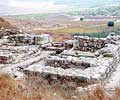
Gezer

Hazor

Solomon’s Mines? American rabbi-archaeologist Nelson Glueck so-named the copper mining at Timna (30 km. north of Eilat) in the 1930s. They were, in fact, Egyptian mines, as hieroglyphs and the near-by temple of Hathor attest.

Solomon’s Pillars? Even the Fundamentalists give up on this one. Geological formation formed over thousands of years.

Solomon’s Port of Ezion-Geber? (1 Kings 9:26)
No trace has ever been found of the Red Sea port where Solomon supposedly welcomed the Queen of Sheba. A craggy granite island in the Gulf of Eliat/Aqabah is prime suspect.

Queen of Sheba?
1 Kings 10 records the unnamed queen’s adoration for Solomon; history records nothing of this fairy tale.

Wisdom?
Biblical “Proverbs of Solomon”?
“Every part of the book bears the mark of foreign influences … The close connection between the first part of the Thirty Sayings with Egyptian Wisdom … is only a special instance.”
J.C. Rylaarsdam (Peake’s Commentary, 444)

Egyptian Wisdom:
“Maxims of Amenhotep III”
1382 – 1344 BC
Solomon – “Smarter than All”
Shortly after their deliverance – variously dated between 1550 – 1200 BC – Yahweh’s chosen people are (apparently) given the ten rules to live by. Yet despite their inside track with God (and witnessing all manner of awful manifestations of his power) their kings are certainly no observers of his rules. In the sacred history, even less devout, mediocre kings follow the fabled “Golden Age of Solomon,” an era and an empire for which there is not the slightest trace of evidence.
King Solomon and Unnamed Pharaoh No. 6 – his father-in-law!
This Pharaoh, it seems, led an expedition into Palestine and made a wedding gift of a ruined city full of corpses:
“Pharaoh the king of Egypt himself had come up and then captured Gezer and burned it with fire, and the Canaanites dwelling in the city he had killed. So he gave it as a parting gift to his daughter, the wife of Solomon.” – 1 Kings 9:16..
The girl was obviously resigned to an open marriage – she shared Solomon with 700 wives and 300 concubines. (1 Kings 11.1) Still, he was a smart fellow. Apparently his wisdom “excelled all the wisdom of Egypt.” (1 Kings 4.30) No kidding.
“Hadad the Edomite” and Unnamed Pharaoh No. 7 – who shelters Solomon’s enemy
Now here’s a curiosity. Hadad receives from this friendly pharaoh a house, bread, land, and marriage into the royal household! Yet it is only the inconsequential pharaonic wife ‘Tahpenes’ who is named (1 Kings 11:19, 20).
Edom – Occasional refuge and long-term foe of Hebrews
Pioneers of copper working, the Edomite kingdom between the Dead Sea and the Red Sea was often at the receiving end of Israelite aggression (well that’s what the Bible says). Apparently, the long-suffering Edomites sheltered David from Saul – before being massacred by him!
Notwithstanding that “every male in Edom had been smitten” (1 Kings 11:15) the Edomites migrated into southern Palestine. ‘Edomea’ became ‘Idumea’ and was conquered and Judaised during time of the ‘Maccabee’ John Hyrcanus.
The Nabataeans moved into the region vacated by the Edomites from the 6th century BC onward. Their city of Petra controlled the lucrative trade routes going north to Damascus and west to Gaza (by-passing any Israelite enclaves). Bands of Israelites probably raided the caravans from time to time – hence the mutual hostility.
Solomon the Builder?
“Monumental structures once attributed to the building activities of Solomon in the cities of Megiddo, Gezer and Hazor have been shown over the years to date from various archaeological periods spanning centuries.“
– Rohl, A Test of Time, p34.
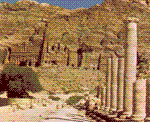
Nabataea
Petra: Unlike the fabled kingdom of Solomon, evidence of the Edomites/ Nabataeans is not in doubt.
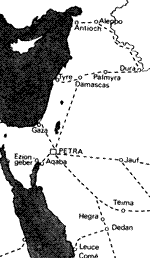
Ancient trade routes
Sources:
Paul Johnson, A History of the Jews (Phoenix Grant, 1987)
Dan Cohn-Sherbok, The Crucified Jew (Harper Collins,1992)
Henry Hart Milman, The History of the Jews (Everyman, 1939)
Josephus, The Jewish War (Penguin, 1959)
Leslie Houlden (Ed.), Judaism & Christianity (Routledge, 1988)
John Romer, Testament (Viking, 1999)
Karen Armstrong, A History of Jerusalem (Harper Collins 1999)
Israel Finkelstein, Neil Silberman, The Bible Unearthed (Simon & Schuster, 2001)
Ahmed Osman, Moses Pharaoh of Egypt (Grafton, 1990)
B.S.J. Isserlin, The Israelites (Thames & Hudson, 1998)
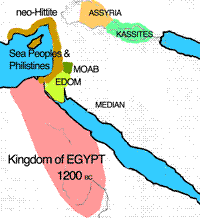
‘Sea Peoples’ & Philistines
1200 – 1000 BC (20th dynasty). Where are the Israelites?
Stock villains of the Old Testament, the Philistines actually established an Iron Age, city-based civilization: Gaza, Ashdod, Ashkelon, Gath, and Ekron. It was vastly superior to the nomadic culture of the ‘hapiru’ slave-traders and subsistence farmers of the hill country.
Gaza, for example, originally Egyptian, was a walled city of about 200 acres, considerably larger than any contemporary settlement in the interior.

Fable
Solomon – too fond of those ‘foreign’ women
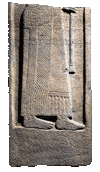
New Evidence of “Solomon” – from Assyria!
Lower portion of stele of a Royal Assyrian Shamshi-Adad V (824-811 BC).
Cuneiform inscription confirms “cedars of Lebanon” cut for temple of the god Shulmânu.

Fringed robe, sceptre …
“I ascended the Lebanon mountains and cut down the mighty beams of cedar. At that time I carried those cedars from Lebanon and at the gate of the temple of Shulmânu, my lord, I laid them down.
The old temple which Shalmaneser, my father, had built, had become decrepit, and I, in my skill, rebuilt that temple from its foundations to its pinnacles.
The beams of cedar from Lebanon I laid on it.
When this temple becomes old and decrepit, may a future prince renew its decrepit parts and return the inscription to its place.”
Shalmaneser III (859-824 BC) was named for the god Shulmânu-Asharêd (“shulmânu is foremost”).
Shalmânu is the Assyrian equivalent of Suleiman and thus Solomon.

Foolish harlot opts for half a dead baby – proves to all Israel ‘wisdom’ of Solomon
“For he was wiser than all men … and his fame was in all nations round about.”
(1 Kings 4.31)
If Solomon was so wise, how could he land up worshipping the wrong gods?
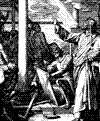
Solomon the Builder?
1 Kings would have us believe that Solomon used ‘costly stone’ and the best timber to build:
Lavish Temple (7 years in construction)
Showplace Jerusalem (built by a 3 month levy on all Israelites plus 150,000 Canaanite slaves)
Magnificent Palace (& another for his Egyptian Queen!)
“House of the Forest of Lebanon” military HQ
“Hall of Pillars” Auditorium
“Hall of Judgement” Law Court
Fortress cities of Megiddo, Hazor & Gezer
Store Cities
Port of Ezion-Geber
Strange how not a single stone of this vast catalogue of construction is unequivocally identified and agreed by archaeologists!
What a Hebrew Army! Israel’s armed might EIGHT times that of Imperial Rome!
“And Joab gave up the sum of the number of the people unto the king; and there were in Israel eight hundred thousand valiant men that drew the sword; and the men of Judah five hundred thousand men.” – (2 Samuel 24.9)
(1 Chronicles 21:5 puts the number even higher!)
Rome, at the height of its power, defended the entire empire with 28 legions of 6,000 troops.
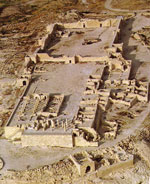
Real, Not Fable
Avdat (Oboda) – Nabataean city in the Negev, destroyed by the Hasmonean king Alexander in the 1st century BC.
Rebuilt to become a prosperous Roman/Byzantine city for several centuries.
